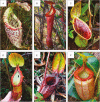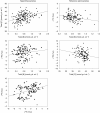Capture of mammal excreta by Nepenthes is an effective heterotrophic nutrition strategy
- PMID: 36306274
- PMCID: PMC9851329
- DOI: 10.1093/aob/mcac134
Capture of mammal excreta by Nepenthes is an effective heterotrophic nutrition strategy
Abstract
Background and aims: While isotopic enrichment of nitrogen (15N) and carbon (13C) is often used to determine whether carnivorous plant species capture and assimilate nutrients from supplemental sources such as invertebrate prey or mammal excreta (heterotrophic nutrition), little is known about how successful the different strategies deployed by carnivorous plants are at obtaining supplemental nutrition. The collection of mammalian faeces by Nepenthes (tropical pitcher plants) is the result of a highly specialized biological mutualism that results in heterotrophic nitrogen gain; however, it remains unknown how effective this strategy is in comparison to Nepenthes species not known to collect mammalian faeces.
Methods: We examined how isotopic enrichment varied in the diverse genus Nepenthes, among species producing pitchers for invertebrate capture and species exhibiting mutualisms for the collection of mammal excreta. Enrichment factors were calculated from δ15N and δ13C values from eight Nepenthes species and naturally occurring hybrids along with co-occurring reference (non-carnivorous) plants from three mountain massifs in Borneo: Mount Kinabalu, Mount Tambuyukon and Mount Trus Madi.
Results: All Nepenthes examined, except N. edwardsiana, were significantly enriched in 15N compared to co-occurring non-carnivorous plants, and 15N enrichment was more than two-fold higher in species with adaptations for the collection of mammal excreta compared with other Nepenthes.
Conclusions: The collection of mammal faeces clearly represents a highly effective strategy for heterotrophic nitrogen gain in Nepenthes. Species with adaptations for capturing mammal excreta occur exclusively at high elevation (i.e. are typically summit-occurring) where previous studies suggest invertebrate prey are less abundant and less frequently captured. As such, we propose this strategy may maximize nutritional return by specializing towards ensuring the collection and retention of few but higher-value N sources in environments where invertebrate prey may be scarce.
Keywords: Nepenthes; Carnivorous plants; functional morphology; investment in carnivory; non-core Caryophyllales; nutrient-acquisition strategy; ultramafic.
© The Author(s) 2022. Published by Oxford University Press on behalf of the Annals of Botany Company. All rights reserved. For permissions, please e-mail: journals.permissions@oup.com.
Conflict of interest statement
The authors declare they have no conflicts of interest
Figures





References
-
- Acres BD. 1972. The ascent of Trus Madi. Sabah Society Journal 5: 365–370.
-
- Adam JH. 1997. Prey spectra of Bornean Nepenthes species (Nepenthaceae) in relation to their habitat. Pertanika Journal of Tropical Agricultural Science 20: 121–134.
-
- Adamec L. 2008. Mineral nutrient relations in the aquatic carnivorous plant Utricularia australis and its investment in carnivory. Fundamental and Applied Limnology 171: 175.
-
- Baj D, Golos MR, Robinson AS. 2022. Nepy – a mobile field reference app for the tropical pitcher plant genus Nepenthes.http://appstore.com/nepy; https://play.google.com/store/apps/details?id=com.davidebaj.nepy; https://play.google.com/store/apps/details?id=com.davidebaj.nepy (9 February 2022, date last accessed).
Publication types
MeSH terms
Substances
LinkOut - more resources
Full Text Sources
Research Materials

